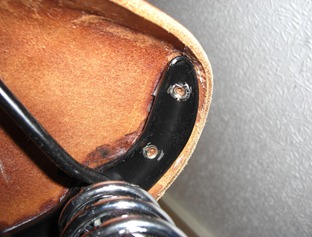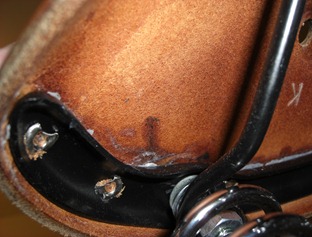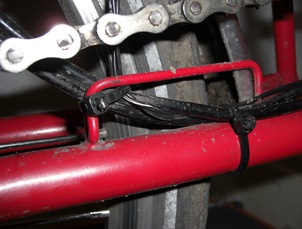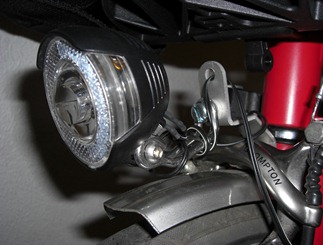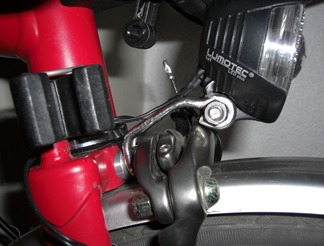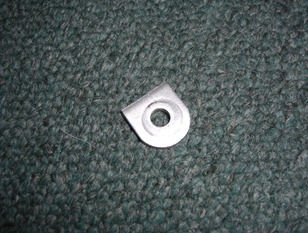The route is mostly very nice, except for a few less appealing sections, particularly near the Ashton end of the Ashton-Marple section of canal. When studying the map, there are a few sections where the canal cannot be seen on this map, heading from Ashton to Marple, the first of these is a long tunnel where a towpath is provided. The second is a tunnel which requires a detour, which is roughly drawn on the map. The route ends at Macclesfield Tesco, the railway station is not far from there and could be walked if preferred. Just across the road from Macclesfield Station is The Waters Green Tavern which I would recommend due to its decent selection of cask ales and Belgian beers. If any of you do try the route I have provided, please feel free to share your experiences in the comments.
Thursday 31 March 2011
Manchester to Macclesfield: Traffic Free
The route is mostly very nice, except for a few less appealing sections, particularly near the Ashton end of the Ashton-Marple section of canal. When studying the map, there are a few sections where the canal cannot be seen on this map, heading from Ashton to Marple, the first of these is a long tunnel where a towpath is provided. The second is a tunnel which requires a detour, which is roughly drawn on the map. The route ends at Macclesfield Tesco, the railway station is not far from there and could be walked if preferred. Just across the road from Macclesfield Station is The Waters Green Tavern which I would recommend due to its decent selection of cask ales and Belgian beers. If any of you do try the route I have provided, please feel free to share your experiences in the comments.
Wednesday 30 March 2011
Ten bike parts & accessories due for a comeback
Hub Gears
Drum/Roller/Coaster Brakes
Briefcase Clips
Saddlebags
Wool
Chain Cases
North Road Handlebars
Steel
Relaxed Geometry
Dynamo Lighting
Friday 25 March 2011
Towpath Closure Mystery Solved
I managed to get a decent amount of time out of the bike yesterday. Before leaving the city centre, I bumped into LC and Northwest Is Best who were taking pictures for their new joint project. I cycled into the city with LC who was on her Pashley, Vita. We cycled through the newly re-designed junction on Booth Street East, which seems to have been re-designed with the aim of decreasing cyclist safety and discouraging cycling.
When the weather is nice, I usually travel to Rochdale by riding to Failsworth and then continuing along the canal. As the weather was so nice, and the traffic so bad, I decided to get onto the Rochdale canal in the city centre and use it all the way. This goes through some of the less bike-friendly parts of the route and some of the more dilapidated parts of Manchester, but was still fairly pleasant.
I had previously spotted that a section of the Rochdale canal towpath was closed, at the time it seemed to be for no apparent reason.
The beginning of the closed section. Yes I am riding the towpath on a Brompton
The crushed gravel surface is new. This section of the canal had previously been nothing more than a narrow rut in the earth, forming one of the two sections of the route which were essentially impassable after rainfall.
The work has not yet finished, the crushed gravel path ends abruptly and the old path can be seen continuing on.
Further on some of the groundwork had been completed but the crushed gravel surface has not yet been put down.
The crushed gravel path returns a bit further along, suggesting that this whole section of canal will have a lovely new path.
The fun wasn’t over yet though, as I reached Sandbrook Park, I noticed my steering was off and looked down to see a front wheel puncture, the first front wheel puncture I’ve had in my entire life. Luckily I had a spare tube, unluckily my mini-pump is Presta only, and Brompton-sized tubes are generally Schraeder. I later managed to borrow a pump and get the bike into good shape for my ride home later that evening (On-road, via Oldham to avoid the ups and downs).
Vehicular cycling can be nice when there are no other vehicles on the road.
Wednesday 23 March 2011
2011 Budget Special
 Image courtesy of The Guardian
Image courtesy of The GuardianPain
Fairness
Budget Concerns
Wednesday 16 March 2011
Risk Compensation Experience
I have written previously about the effects of risk compensation on road safety. A good example of this effect is the Munich Taxi experiment, where a fleet of taxis, half with ABS and half without were secretly monitored and the differences examined. It was found:
“Drivers of cabs with ABS made sharper turns in curves, were less accurate in their lane-holding behaviour, proceeded at a shorter forward sight distance, made more poorly adjusted merging manoeuvres and created more "traffic conflicts". This is a technical term for a situation in which one or more traffic participants have to take swift action to avoid a collision with another road user.[3] Finally, as compared with the non-ABS cabs, the ABS cabs were driven faster at one of the four measuring points along the route. All these differences were significant.”
In brief, the increased safety offered to the vehicle operators/occupants by the improved brakes was compensated for by an increase in risk-taking behaviour by the vehicle operators.
I currently operate a “fleet” of three bikes, all of which have different types and combinations of brakes:
The DL-1 has 70 mm Sturmey Archer drum brakes in both the front and rear wheels. These offer reasonable stopping power and supreme durability, requiring almost zero maintenance. Sturmey Archer drums offer good modulation, with light braking being easily controllable and hard braking available if you need it when you really squeeze the levers.
The Sturmey Archer drum brakes; front (top) and rear (bottom)
The Brompton has calliper brakes front and rear. These were presumably chosen because they offer reasonable stopping power and reasonable durability whilst minimising weight (which is an important consideration for a folding bike, unlike a full-sized transport bike). A peculiarity of the Brompton is that the rear brake seems to offer more stopping power than expected, whilst the front feels weaker than expected. The callipers offer similar stopping power and modulation to the Sturmey Archer drum brakes, but are exposed and thus require more maintenance.
The Brompton calliper brakes; front (left) and rear (right)
The Yuba Mundo has a more exotic brake configuration; a rear V-brake and a front 185 mm Avid Juicy hydraulic disc brake. This combination was chosen because the original front V-brake did not offer what I felt was appropriate stopping power or modulation for a loaded Yuba Mundo. The rear V-brake is adequate; offering a lot of stopping power but poor modulation, with a small amount of brake lever travel the brakes make the transition from doing hardly anything to slow the bike to locking up the rear wheel. The front disc brake offers an extreme level of stopping power, which is ideal when the bike is loaded. It also offers good modulation for when a small amount of braking is required. When the bike is unloaded/lightly loaded, it is able to stop incredibly quickly.
The Yuba Mundo front hydraulic disc brake (top) and rear V-brake (bottom)
Whilst I use all three bikes regularly, I rarely use different bikes in quick succession. A few weeks ago, I returned from a 30 km ride on the Yuba Mundo to pick up some wheel building parts which I dropped off at home. I had to pop back to work immediately afterwards and took the DL-1. When I approached the first set of traffic lights I experienced risk compensation first hand; after riding the lightly-loaded Yuba Mundo over a few hours I had become accustomed to riding faster and braking later for a given set of road conditions, and I had to brake very hard on the DL-1 to stop in a space which the Yuba Mundo would have been able to stop in easily. This is why I worry when I hear about engineering-based safety enhancements such as ABS in cars, they improve the safety of the vehicle’s occupants but this is often at the expense of everyone outside of the vehicle.
Tuesday 15 March 2011
Anecdotes and Evidence
The petition to block the proposed Cyclists (Protective Headgear) Bill in Northern Ireland has finally attracted some attention from the larger press outlets. With wider exposure comes the usual heated discussions over helmets in the comment threads. Many of you know my own stance on helmets, but I would not want to force anyone who wishes to cycle with a helmet to do so without one.
A helmet slpit along the vents, a common mode of failure. Image courtesy of cyclehelmets.org
One type of comment which comes up frequently on these comment threads follows the general form of “A helmet saved my/a friend's life.” This is not particularly surprising, during my own school days I remember being shown emotive video footage of an interview with a teenager who had survived being hit by a motorist whilst he was on his bike. He proudly showed the camera his helmet, split in two and with an unshakable conviction he stated that it had saved his life. In the years since this experience, the arse-about-face approach to road safety has continued to gain traction and find its way into online materials aimed at school-age children.
When listening to stories claiming a helmet saved someone’s life, it is important to remember that anecdotes aren’t the same as evidence. Consider the following:
With no control experiment, where all variables other than whether or not the rider was wearing a helmet left unchanged, it is impossible to state with any confidence whether or not the helmet had made a difference, or to appropriately quantify any difference it may have made.
The effects of risk compensation also need to be considered. For those who have been told and accepted the idea that a helmet will save their life, there will be an increase in their perceived safety which will have an effect on their behaviour. This also goes for the operators of motor vehicles, who will perceive a helmet-wearing cyclist as being less at risk from their vehicle. It is possible that the change in behaviour both on the part of the cyclist and the motorist caused by the effects of risk compensation were instrumental in leading to the collision. This effect has been studied with ABS in the Munich taxi experiment, and can also be seen in the increase in the severity and number of pedestrian and cyclist casualties following the introduction of compulsory seat-belt legislation, drivers felt safer with seat-belts and adjusted their behaviour to compensate for the reduced risk to them by driving faster and braking later. This resulted in decreased safety for those not travelling inside a car.
There are safety concerns attached to wearing a helmet, including increased risk of rotational brain injury which can be further exacerbated by the interaction between the air vents on a helmet and irregularities in the road surface leading to an increased risk of neck injuries. These effects are often dismissed due to the acceptance even amongst helmet advocates that there are limits to the protection a helmet can provide; if a helmet-wearing cyclist is injured in a collision, the injuries they sustain are uncritically regarded as being “less substantial than if they had been without a helmet,” when in fact they may have been exacerbated or even caused by the wearing of a helmet.
Plenty of cyclists survive collisions, accidents and other incidents despite not wearing a helmet. Unlike the sensational “Life-saving helmet,” stories we all see whenever there is a discussion regarding helmets, people who survive collisions, accidents and other incidents whilst not wearing a helmet rarely link their survival to the fact that they were not wearing a helmet.
It is human nature to find causal links between events which may in fact be unrelated. This is how we end up with things like lucky pants and ritualistic behaviour of athletes and sports-fans; people struggle to separate correlation from causality. For example, I have been involved in several minor incidents due to motorists over the years and survived each one of them. On every occasion I was wearing boxer shorts, but it would be foolish to state that my survival was definitely caused by the fact that I was wearing boxer shorts. At the very least I’d want to see the results from a control experiment where I was wearing budgie-smugglers in the same situations.
Monday 14 March 2011
Lumotec Lyt on a Brompton
After my initial attempts at modifying the reflector bracket into a suitable dynamo lamp mount failed, I am pleased to announce that the standard Brompton dynamo lamp wire mount is compatible with the B&M Lumotec Lyt. The arrangement doesn’t interfere with the Brompton luggage system, which was the main concern with this arrangement. This provides Brompton owners to a better alternative to the standard Brompton-branded B&M Lumotec Halogen lamp and a cheaper alternative to the high-end B&M Cyo which is also spec’d by Brompton (when buying the SON hub version of the dynamo wheel).
The space between the Lyt and the bag is actually bigger than it appears in the picture, with a good cm of clearance between the Lyt and the luggage frame.
Thursday 10 March 2011
Census: Shape the Future of Transport
These are the two questions relating to transport in the census.
H14) In total, how many cars or vans are owned, or available for use, by
members of this household?
• None
• 1
• 2
• 3
• 4 or more, write in number
41) How do you usually travel to work?
• Work mainly at or from home
• Underground, metro, light rail, tram
• Train
• Bus, minibus or coach
• Taxi
• Motorcycle, scooter or moped
• Driving a car or van
• Passenger in a car or van
• Bicycle
• On foot
Somehow, after seeing the posters, I was expecting transport to be a bigger part of the census. It is at least nice that bicycle is an option on question 41.
Wednesday 9 March 2011
Light-Evening Landmark

Friday 4 March 2011
Brompton Review
It’s been over a month now since I bought my new-to-me Brompton, during which time it has been used extensively. I feel I have now had enough experience with it to do a proper review, you can read my initial impressions here.
The main event when looking at folding bikes for many is the fold itself. As is shown in my original post, the fold is neat and compact and the oily chain is tucked away in the centre of the package. Unlike most other folding bikes I’ve used, it doesn’t try to come unfolded whilst being carried, which is one of the best aspects of the design. Once you have got the hand of it, you can fold the bike in little more than a few seconds, with unfolding taking little longer. This is ideal because although the folded bike is compact and forms a sturdy package, you wouldn’t want to carry it folded up for any serious distance. There are lighter options available, but realistically even they won’t make carrying the folded bike for any length of time much more pleasant.
I have ridden the bike over reasonable distances on several occasions (several trips from Macclesfield to Manchester), and the compact and clever folding ability of the bike does not diminish the ride. The wheel-base makes the bike feel like a much larger bike when ridden, which gives a better experience than many of the other folding bikes I have tried. The ride quality is similar to the Raleigh Twenty, although the steering is a bit more twitchy at lower speeds. The M-type bars give a reasonably upright posture, although the fact that the seat-tube does not terminate at the bottom bracket means that the virtual seat-tube angle gets steeper with saddle height. This can be corrected to a certain extent by moving the saddle fore/aft.
The stock gearing is reasonably broad, although a wider range would be desirable, and is available in the form of the 3-speed hub & 2-speed derailleur-equipped 6-speed Brompton, or even just the BWR wide range 3-speed hub. The left folding pedal is great, but the non-folding right pedal is less impressive, requiring replacement a few week after I purchased the bike.
I never used the stock-saddle, but it looked like it was designed for the S-type Brompton rather than the more upright posture of the M and P type bikes. It also didn’t look particularly lady-friendly. The caliper brakes are good enough, although the back brake seems to offer more power than the front, which I believe is an oddity of the Brompton in general, not just mine. I am thankful that the model I got was new enough to have the dual-pivot Brompton brake, which is reported to be a lot better than the old single-pivot model.
After a few weeks, I decided to take the plunge and fork out for the Shimano dynamo wheel before the price increase. The dynamo hub is great, it produces a reasonable output in the lights at walking speed without noticeable drag. Sadly I had to sacrifice the front dynamo light on the Yuba due to budgetary constraints, but with a little hammer adjustment, the Lyt can be used with the Brompton without interfering with the luggage system.
Overall I would recommend the Brompton to anyone. If you only wish to own a single bike, this could be it. It is remarkably versatile, being able to carry a decent load in a wide variety of high quality proprietary luggage options, cover longer distances well, offering a comfortable riding position (although it is no roadster), reliable hub gearing and on top of all that if folds into a neat package, opening up new opportunities to cycle when travelling by bus, rail or air.
Squeak
On Monday morning I rode to work from Macclesfield on the Brompton. The whole ride was accompanied by a chorus of squeaks which was very irritating. I eventually managed to trace the sources of the squeaks down and fix them, and I present them here for the benefit of other Brompton owners.
1) Not a Brompton issue per se, but the B67 I got for Xmas which is currently residing on my Brompton has passed through the initial “Hard” phase and is now in the “Creaky” phase. With the B66 on the DL-1 this was not really an issue, because there is little other noise from the bike I just ignored it and it went away.
The creaking is not caused by the springs as you might expect, but by the leather rubbing on the metal pads on the underside to which it is riveted. A bit of lubrication sorts this problem out, the approach I took was to melt some Proofide in a teaspoon with a match, pour it onto the interface between metal and leather and slightly stress the saddle so that it can easily get into the gap.
2) The Rear brake cable and gear cable were rubbing on the side of the tyre when under hard pedalling. This was fixed by using a few cable-ties to hold the cables in a favourable position within the cable-gathering loop on the right seat-stay.
3) It turned out that the main source of the racket was the suspension block, with the saddle acting as a sort of speaker for the noise it generated. The suspension block is held onto the rear triangle by a single bolt, which once removed allows the block to be detached and disassembled. I lubricated the entire length of the bolt with lithium grease and re-attached the suspension block to the bike. I also tightened the bolt much futher than it had been when previously, resulting in a firmer, more compressed block which moves less.
These three tweaks have effectively eliminated the noise from the Brompton, so I can now get on with the business of enjoying the ride instead.
Tuesday 1 March 2011
Mechanical Problems
I’ve had a few mechanical problems with the bikes this past week. The right hand pedal of Brompton has an aluminium outer cage, which I managed to snap whilst riding last week. Luckily replacement pedals are readily available and quite cheap. I expect that I must have hit the pedal on the ground one too many times, and the metal gave out suddenly whilst I was riding.
A steel outer cage would not have failed quite so suddenly (if at all), and there would have been a negligible weight penalty compared to the aluminium part.
On Saturday evening, I had my first puncture on the DL-1 (and my first puncture at all in over a year). An industrial staple had worked its way through the tyre on the ride to a friend’s house and when I came to leave it had gone flat. When I got it home I attempted to patch it, but after applying the patch I kept found another hole. I decided to go to Bicycle Doctor for a replacement tube, intending to patch the old one to keep as a spare. However, after patching 6 holes (some of which were close together enough to use a single patch for) I found 3 more and decided to bin the tube.
Sadly, my front lamp mounting bodge-up also snapped this week. The aluminium reflector bracket I had re-purposed (admittedly it wasn’t designed for anything more than a reflector) snapped whilst I was riding over the high-quality road surfaces found in Stockport. Thankfully I ordered the proper Brompton bracket online last week, and it should be with me shortly.
Before the bracket snapped
Temporary solution until replacement bracket arrives from Brompton, this current solution slightly interferes with the front brake
Remains of reflector bracket
With most bike components I’d rather have durability over miniscule weight savings. The puncture was the first one in over a year, thanks to choosing practical tyres designed for durability over lightness. For non-competitive everyday cycling, why worry about a few extra grams here and there? Obsessing over bicycle weight can lead many people to make terrible decisions when choosing a practical everyday bike.







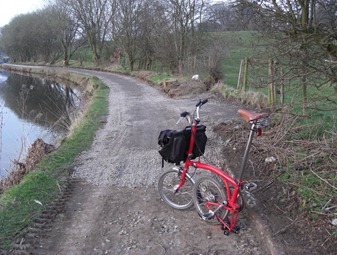

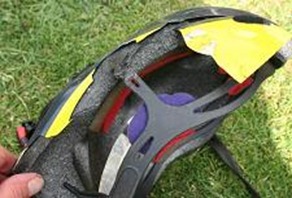
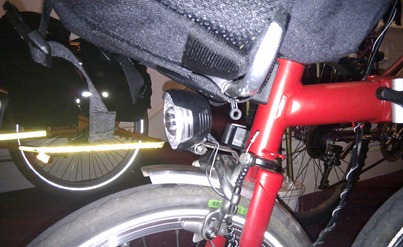
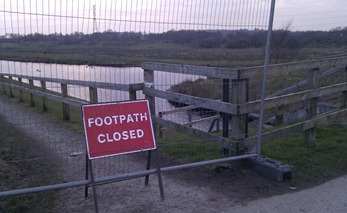

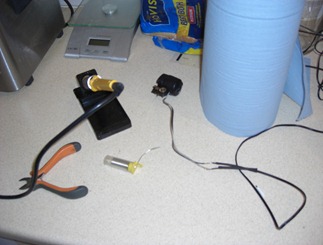
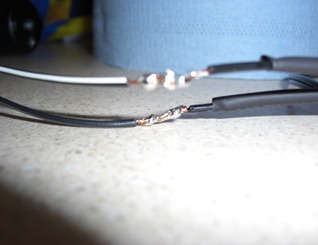
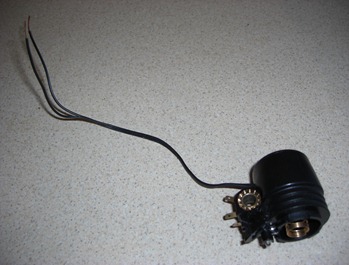
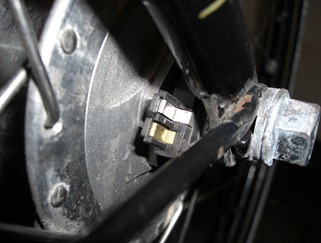

![CIMG2433[5] CIMG2433[5]](http://lh3.ggpht.com/_R48YSqUGDr8/TXEQQyJ-NWI/AAAAAAAABI0/H-gRco4IIAs/CIMG2433%5B5%5D_thumb%5B2%5D.jpg?imgmax=800)
